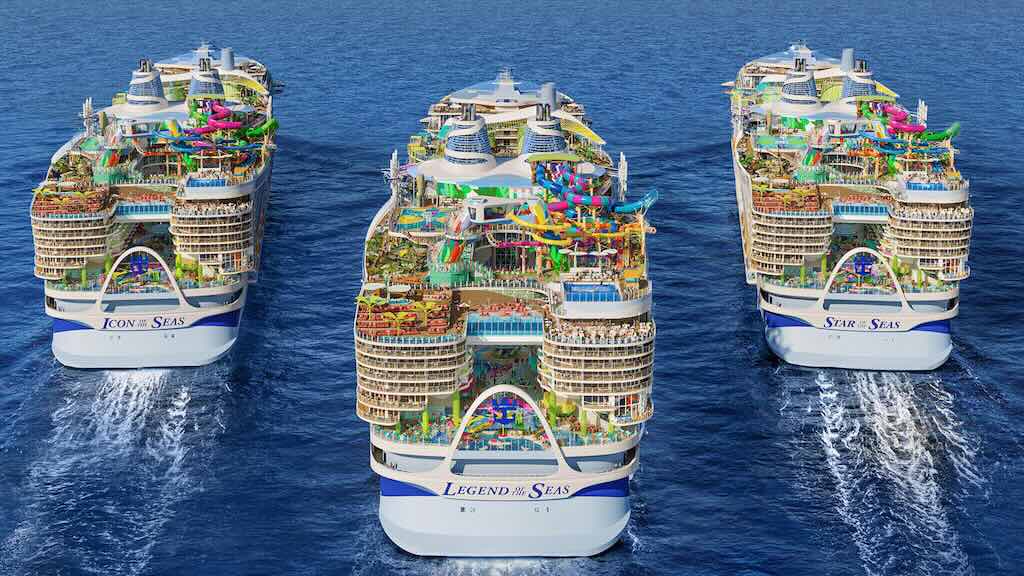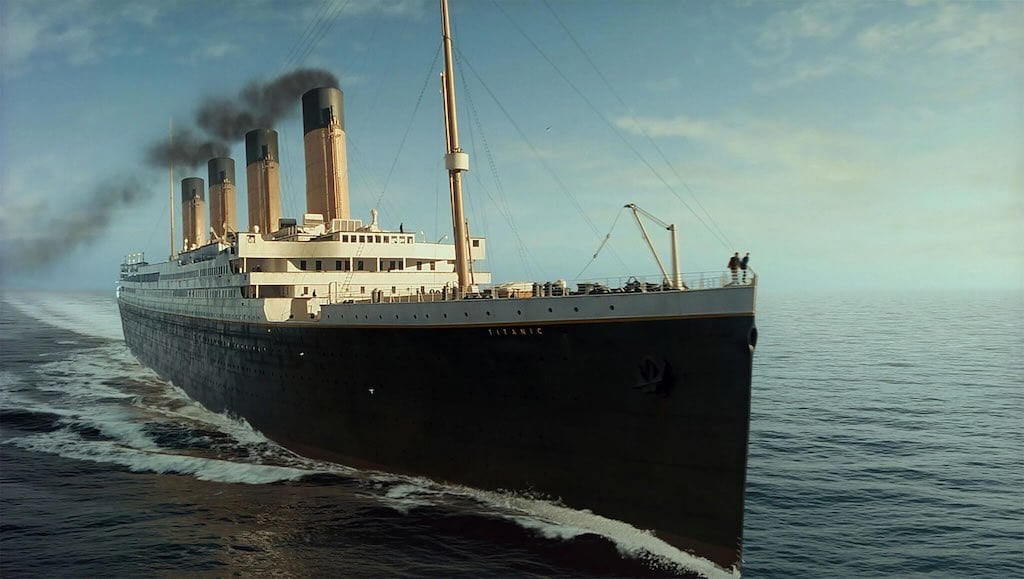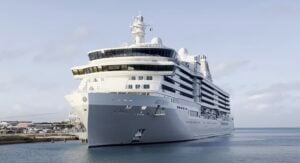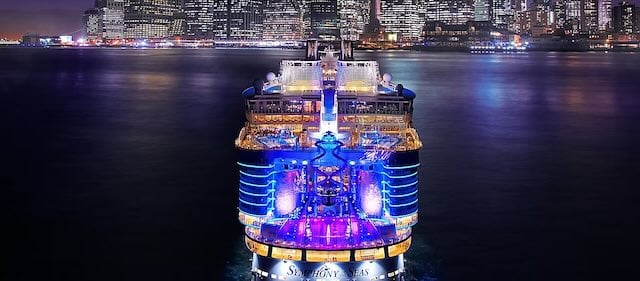Cruising has come a long way in just over a century. Back in 1912, Titanic was the pinnacle of luxury and engineering. Fast forward to today, and Royal Caribbean’s upcoming Legend of the Seas is rewriting what a cruise ship can be. Putting Legend of the Seas vs Titanic side by side isn’t just fascinating—it’s a jaw-dropping look at how far the industry has evolved.

Table of Contents
Legend of the Seas vs Titanic
When Titanic set sail in 1912, it was hailed as the largest and most luxurious ship the world had ever seen. Over a century later, Royal Caribbean’s Legend of the Seas is preparing to launch as part of the futuristic Icon Class. At nearly five times Titanic’s size, Legend is more than just a ship — it’s a floating city with waterparks, ice rinks, skywalks, and neighborhoods designed for every type of cruiser.

But how exactly do these two famous ships compare? From sheer size and passenger capacity to technology, safety, and cultural legacy, this guide breaks down Legend of the Seas vs Titanic to show how cruising evolved from coal-fired steamships into today’s jaw-dropping mega-resorts at sea.
Legend of the Seas vs Titanic – Size
When it comes to ship size, the numbers alone tell an astonishing story. Titanic measured about 882 feet in length and weighed in at roughly 46,000 gross tons. At the time, this made her the largest moving object ever built — a true marvel of the early 20th century.
Fast forward to today, and Legend of the Seas completely dwarfs her. Scheduled to debut in 2026, this Icon-class giant will stretch nearly 1,200 feet long with a staggering 250,800 gross tonnage. To put that into perspective, Legend is more than five times the size of Titanic.
This isn’t just a small step in shipbuilding — it’s a giant leap that shows how far cruising has come. If you’re fascinated by how modern ships compare to Titanic’s size, check out our full guide on Star of the Seas vs Titanic – Size, Stats & Surprising Facts (2025 Guide).
Legend of the Seas vs Titanic – Capacity
Titanic was designed to carry just over 2,200 passengers and crew combined. On her maiden voyage, about 1,316 passengers and 885 crew were onboard. Even then, she was considered massive, with more staff per guest than many liners of her era.
Now, step aboard Legend of the Seas and the scale is almost unbelievable. This ship is built to host around 5,610 guests at double occupancy, with the ability to max out near 7,600 passengers. Supporting them will be a crew of nearly 2,350 people, ensuring everything from fine dining and entertainment to daily housekeeping runs smoothly.
That means Legend can carry over three times as many people as Titanic — and still offer far more space, variety, and activities. For a wider perspective, take a look at how other ships stack up in Harmony of the Seas vs Titanic: 9 Stunning Facts in a Huge Comparison.
Legend of the Seas vs Titanic – Power
Titanic relied on coal-fired steam engines, burning over 600 tons of coal per day just to keep her moving across the North Atlantic. Stokers worked around the clock in hot boiler rooms, shoveling coal to power her massive triple-screw propulsion system. It was state-of-the-art in 1912, but also labor intensive and highly polluting.
By contrast, Legend of the Seas is powered by liquefied natural gas (LNG) and advanced fuel-cell technology. Not only does this reduce harmful emissions, but it also provides smoother, more efficient cruising. This makes Legend one of the most eco-friendly cruise ships ever built, a massive leap forward from Titanic’s smoky legacy.
The evolution from coal to LNG isn’t just about efficiency — it highlights how cruising has shifted toward sustainability, safety, and innovation. If you’re curious about how modern propulsion compares to early liners, check out our deep dive on Titanic vs Modern Cruise Ships: 11 Shocking Differences That Will Blow Your Mind.
Legend of the Seas vs Titanic – Amenities
Titanic offered what was considered unparalleled luxury in 1912: fine dining rooms, a Turkish bath, a squash court, a grand staircase, and even one of the first swimming pools at sea. For first-class passengers, it was the pinnacle of style and sophistication.
Now step onto Legend of the Seas, and it feels like an entirely different world. This ship will feature the largest waterpark at sea, complete with multi-story slides, a surf simulator, and the Crown’s Edge skywalk that dangles riders over the ocean. Add in the AquaTheater with a 55-foot waterfall, an ice rink, a swim-up bar, and entire neighborhoods built for families, thrill-seekers, and relaxation — and you start to see just how far cruising has evolved.
It’s not just about transportation anymore; it’s about creating a floating resort. For another look at how modern mega-ships blow Titanic out of the water in amenities, read Symphony of the Seas vs Titanic: A Huge Comparison of Two Iconic Ships.
Legend of the Seas vs Titanic – Safety
Titanic was famously called “unsinkable”, yet her tragedy became the ultimate reminder of maritime vulnerability. She carried just 20 lifeboats, enough for barely half the people onboard. Communication relied on Morse code wireless telegraphs, and iceberg warnings were often delayed or ignored. The disaster led to sweeping changes in maritime law.
Fast forward to Legend of the Seas, and the contrast is staggering. This ship is built under the SOLAS (Safety of Life at Sea) regulations that came into existence because of Titanic. Today, every passenger has an assigned lifeboat seat, evacuation drills are mandatory, and high-tech navigation systems continuously scan for hazards.
Onboard safety extends far beyond lifeboats. Legend will feature stabilizers to reduce motion, fire suppression systems throughout, and advanced medical facilities. It’s a floating city designed with layers of redundancy — something Titanic could only dream of.
For a deeper look at the cultural impact Titanic’s safety failings had, don’t miss our roundup of 10 Best Titanic Museums in the World (2025 Guide to Unforgettable History).
Legend of the Seas vs Titanic – Itineraries
In 1912, Titanic’s purpose was simple: luxury transatlantic crossings. Her maiden voyage charted the now-infamous course from Southampton to New York, cutting across the icy North Atlantic. Tragically, her journey ended in the exact spot where she struck an iceberg and sank. For NOAA’s official Titanic Collection, which features expedition data, images, and research on the wreck, explore their dedicated resource. You can also see our guide on Where the Titanic Sank: Exact Location (With Map), Depth, and Haunting Facts.
Legend of the Seas, on the other hand, is built for variety and adventure. When she debuts in 2026, itineraries will include Mediterranean summers with ports like Barcelona, Rome, and Athens, followed by Caribbean winters sailing to Royal Caribbean’s private island Perfect Day at CocoCay. Unlike Titanic, which focused on crossing the Atlantic as fast as possible, Legend is designed to maximize the vacation experience at every stop.
From sun-soaked beaches to historic cities, modern cruising isn’t just about getting from A to B — it’s about the journey itself.
Legend of the Seas vs Titanic – Environment
Titanic’s engines burned thousands of tons of coal during her voyages, releasing thick smoke and soot into the atmosphere. Environmental concerns weren’t even a thought in 1912. The goal was simple: power the largest ship in the world across the Atlantic as quickly as possible.
Legend of the Seas represents a new era. As part of the Icon Class, she will run on liquefied natural gas (LNG), the cleanest-burning fossil fuel available to cruise ships today. This dramatically reduces sulfur emissions and greenhouse gases. Onboard systems will also recycle waste heat, use advanced water treatment, and minimize food waste.
The contrast is staggering — from coal dust and ash on Titanic to sustainability at the forefront of Legend’s design. This evolution reflects how modern cruising isn’t just about comfort and luxury, but also about protecting the oceans ships sail on.
For a broader breakdown of how cruise ships today differ from Titanic in every way, take a look at Titanic vs Modern Cruise Ships: 11 Shocking Differences That Will Blow Your Mind.
Legend of the Seas vs Titanic – Cabins
Titanic’s accommodations reflected the rigid class system of the early 1900s. First-class passengers enjoyed lavish suites with private promenades, ornate woodwork, and fine furnishings. Second-class cabins were still comfortable by the standards of the time, while third-class passengers often bunked in shared quarters with limited privacy.
On Legend of the Seas, the concept of cabins has been completely reimagined. Guests can choose from multi-level family suites, balcony staterooms overlooking the ocean, virtual-view inside rooms, and even swim-up suites that open directly into a private pool. Instead of being divided by social class, today’s cruisers select accommodations based on lifestyle and budget.
What’s more, Legend’s cabins are designed with modern comfort in mind: high-speed Wi-Fi, smart TVs, luxurious bedding, and innovative storage. Titanic’s first-class elegance was iconic, but today’s staterooms combine comfort, technology, and style in ways unimaginable in 1912.
For another comparison that shows just how far cabins — and entire ships — have evolved, check out Icon of the Seas vs Titanic: 13 Astonishing Facts That Show How Cruising Changed Forever.
Legend of the Seas vs Titanic – Tech
In 1912, Titanic was equipped with what was then cutting-edge: a Marconi wireless telegraph for sending Morse code messages across the Atlantic. It was revolutionary for its time, but communication was limited, slow, and dependent on operators relaying signals. Navigation relied on lookouts and rudimentary charts, with no radar or satellite support.
Fast forward to Legend of the Seas, and the technology feels light-years ahead. This ship will feature satellite internet (Starlink-enabled) for streaming and video calls at sea, advanced navigation systems with real-time iceberg and hazard detection, and full digital integration across the entire guest experience. Passengers can use Royal Caribbean’s app to make reservations, track kids onboard, or even unlock stateroom doors.
Entertainment technology is equally mind-blowing. From robot bartenders to projection-mapping AquaTheater shows and an indoor ice arena, Legend’s tech is designed to wow guests at every turn. What was once considered a miracle on Titanic is now just part of the everyday cruise experience.
For another eye-opening look at how far ships have come, see Will the Titanic Ever Be Brought to the Surface? 5 Powerful Reasons It’s Impossible.
Legend of the Seas vs Titanic – Legacy
Titanic’s legacy is unmatched. Over a century later, her story continues to capture the world’s imagination. Books, films, and museums keep her memory alive, and she remains a symbol of both human ambition and human vulnerability. More than 1,500 lives lost turned her into a cautionary tale that permanently reshaped maritime laws and safety standards. If you want to experience this history firsthand, check out our guide to the 10 Best Titanic Museums in the World (2025 Guide to Unforgettable History).
Legend of the Seas, on the other hand, represents the future of cruising. As the third Icon-class ship, she pushes boundaries with record-breaking features, eco-friendly propulsion, and entertainment options that Titanic’s designers could never have imagined. While Titanic stands as a historic cultural icon, Legend is destined to become a symbol of innovation, family fun, and sustainability in the modern cruise era.
Put simply: Titanic’s story will always live in history, but Legend of the Seas shows us what’s possible today — and tomorrow.
Legend of the Seas vs Titanic – Jim’s Take
Whenever I line up Legend of the Seas vs Titanic, I can’t help but shake my head at the sheer difference. Titanic was a marvel of her age, built with pride and craftsmanship that still impresses me today. But she was also fragile, limited by the technology of 1912, and tragically remembered for what went wrong.
Legend of the Seas, meanwhile, feels like something out of the future. She’s safer, cleaner, and designed to give guests experiences that people in Titanic’s time couldn’t have dreamed of — like waterparks, skywalks, and ice rinks at sea.
For me, comparing the two isn’t about saying one is “better.” It’s about appreciating just how far cruising has come. Titanic’s story gives us perspective, while Legend shows us possibility. And that’s why I think both ships, in their own way, will always be legendary.
Legend of the Seas vs Titanic – Conclusion
When you look at Legend of the Seas vs Titanic, the comparison is almost surreal. Titanic was the height of luxury in 1912, with ornate suites, elegant dining, and steam engines that symbolized power. Yet, she was limited by her time — both in safety and in scale.
Legend of the Seas, launching in 2026, represents everything cruising has become: larger, safer, greener, and packed with experiences for every type of traveler. From eco-friendly propulsion to entire neighborhoods at sea, she shows just how far the industry has evolved.
In the end, Titanic will forever remain a cultural touchstone, while Legend of the Seas sets the stage for the future of cruising. Together, they remind us where we’ve been — and just how far we’ve sailed.






